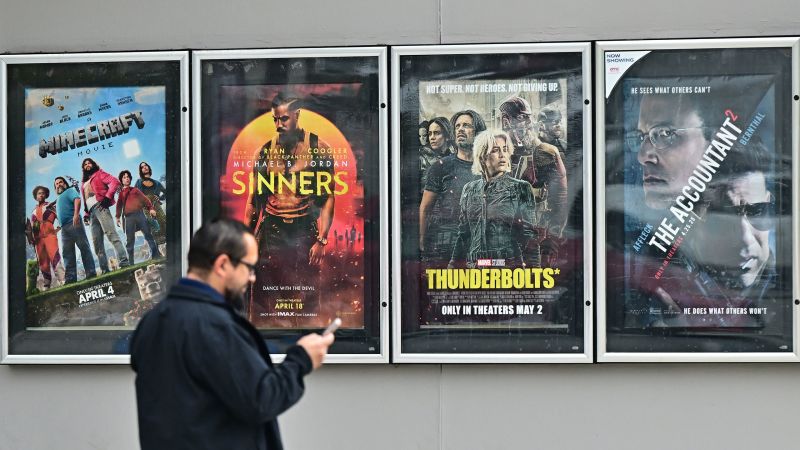The film industry has faced considerable challenges in recent years, particularly following its attempt to rebound from the impact of the COVID-19 pandemic. Not only did studios grapple with the ramifications of a writers’ strike, but they also encountered blockbusters that underperformed at the box office and struggled with the turbulent decision-making process concerning the optimal timing for theatrical releases versus streaming premieres. These factors have led to a conundrum for many industry insiders, accentuating fears regarding long-term financial sustainability.
The domestic box office trends indicate a sluggish start, especially during the month of January, when there was a notable absence of a strong carryover hit from the holiday season or unexpected audience favorites. This slow period revived apprehensions about the film industry’s ongoing financial difficulties. Notably, between January 1 and April 3 of 2025, box office revenues were down by 13% compared to the same period from the previous year, which itself had seen a decline of 7.6% compared to 2023. Paul Dergarabedian, a senior analyst at Comscore, mentioned that while first-quarter slumps are common, they can be mitigated by the presence of popular holdover films or breakout hits.
One major release of 2025, Marvel’s “Captain America: Brave New World,” managed to open in February with a robust haul of over $100 million during the four-day Presidents Day weekend. However, it thereafter experienced a dramatic 68% drop in earnings during its second week. This trend continued for the rest of March, with Comscore reporting a nearly 50% decrease in box office numbers compared to the same month the previous year, exacerbated by the underwhelming performance of Disney’s “Snow White.”
Despite this initial downturn, the tide began to turn in April, as a slew of new films rekindled interest among audiences, powered largely by nostalgia and positive word-of-mouth. Warner Bros. Pictures emerged as a driving force for this revitalization, with their release of “A Minecraft Movie,” which debuted to an impressive $163 million. Additionally, the critically acclaimed “Sinners,” directed by Ryan Coogler, exceeded expectations with over $275 million in domestic earnings. April’s rejuvenation was further solidified by a record-setting Memorial Day weekend, witnessing a 22% increase in box office sales compared to the previous year.
Disney’s live-action adaptation of “Lilo & Stitch” stood out, opening with a remarkable $183 million and has since grossed over $380 million, posing a potential challenge to “Minecraft” for this year’s top grosser. The month of May continued to produce hits, such as the Marvel film “Thunderbolts” and “Mission: Impossible — The Final Reckoning,” solidifying a trend of recovering box office revenues. June maintained this momentum with the opening of Universal’s “How to Train Your Dragon,” which grossed nearly $135 million since its debut weekend.
As the overall box office approached the $4 billion mark for the year, representing an 18% increase compared to the prior year, there was optimism within the industry. Experts suggest that a rise in the quality of films released is a key driver of this recovery, with high-profile movies, including Warner Bros.’ “F1” and Universal Pictures’ “M3GAN 2.0,” anticipated to make substantial impacts upon their releases in July. Other notable upcoming films include “Jurassic World Rebirth” and “Superman,” which have been heralded as potential box office giants for the summer season.
However, while the box office’s recovery may seem promising, analysts indicate that the industry still faces consequential risks. Daniel Loria, the editorial director at Boxoffice Pro, pointed out the need for a diverse film lineup to meet varying audience preferences, including genres like family films, action thrillers, horror, and romantic comedies. Despite the strong performances in April and May, projections for June suggest fluctuations, with expected declines in box office revenues both compared to last year and to pre-pandemic averages.
In challenging economic circumstances, movie-going has remained a favored form of inexpensive entertainment for many consumers seeking escapism. Movie theaters provide a social setting that enriches the experience, evidenced by a special screening of “Sinners” hosted in Clarksdale, Mississippi, a location that inspired the film’s narrative. Discounts on screenings offered by chains like AMC reflect sensitivity to price, with a growing audience trend towards PG-rated films serving family audiences.
Consequently, the narrative about the film industry’s recovery is still evolving, as discussions of competition among studios persist, with varying degrees of success illustrating the unpredictable nature of audience engagement with cinematic offerings. Given the cumulative performances of recent releases, industry experts remain cautiously optimistic, asserting that the recovery depends largely on ongoing quality and diversity in film production.



